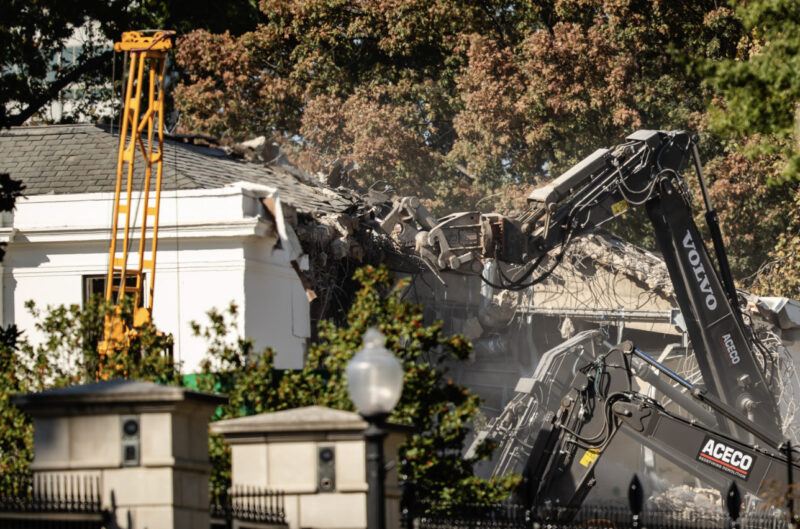Top Stories
White House Unveils $300M Ballroom Donor List Amid Construction

UPDATE: The White House has just released a detailed list of private donors contributing to the ambitious $300 million ballroom project, which is currently under construction on the grounds. This development is pivotal as the new 90,000-square-foot ballroom aims to address longstanding space limitations for significant state functions.
The announcement, made earlier today, highlights contributions from major corporations including Amazon, Apple, Google, and Microsoft, among others. President Donald Trump confirmed that no taxpayer funds will be utilized for this project, emphasizing the role of private donations in bringing this vision to life.
The ballroom’s construction officially began in September following a plan revealed on July 31. White House press secretary Karoline Leavitt stated that this long-awaited facility will enable the White House to host larger events, eliminating the need for temporary tents currently used for major functions.
Leavitt remarked, “For over 100 years, staff and occupants have longed for a large event space on the White House complex.” The current facilities are insufficient for accommodating the scale of events that presidents wish to host, especially those honoring world leaders.
Approximately $22 million of the funding has already been allocated from a settlement related to a 2021 lawsuit involving Trump and YouTube, a Google subsidiary. This funding underscores the project’s financial backing and the administration’s commitment to enhancing the White House’s functionality.
The ballroom will be connected to the existing East Wing, which has undergone renovations since its initial construction in 1902. Significant demolition efforts commenced on October 22, with Trump stating that after extensive consultations with top architects, a substantial portion of the East Wing would be removed to meet modern needs.
Leavitt clarified that while some questions have arisen regarding the project’s oversight under the National Historic Preservation Act of 1966, a specific exemption allows the president to proceed without extensive regulatory review. “A submission is not required legally for demolition,” she affirmed, confirming that plans would be submitted to the National Capital Planning Commission when necessary.
As construction progresses, the administration is committed to creating a space that reflects the grandeur of the White House. “We’re all grateful for the modifications made by presidents in the past,” Leavitt added, highlighting the historical significance of such projects.
The donor list also includes high-profile names such as Lockheed Martin, Caterpillar Inc., and Meta Platforms, along with numerous foundations and private individuals. The comprehensive backing from the private sector underscores a significant shift in how presidential projects are funded.
The urgency surrounding this ballroom development is palpable as it promises to reshape the White House’s event hosting capabilities for generations. As construction continues, the American public will be watching closely to see how this project evolves and what it means for future presidential engagements.
Stay tuned for more updates on this developing story as the White House moves forward with its ambitious plans.
-

 Business6 days ago
Business6 days agoUK to Finalize Stablecoin Regulations by 2026, Boosting Crypto Sector
-

 Business7 days ago
Business7 days agoU.S. and U.K. Target Cybercriminal Networks, Seize $15 Billion
-

 World6 days ago
World6 days agoMilitary Artillery Plan Sparks Safety Concerns Along California Highway
-

 Lifestyle7 days ago
Lifestyle7 days agoKISS OF LIFE’s Natty Dazzles in Micro-Shorts at Seoul Event
-

 Sports7 days ago
Sports7 days agoDomenico Doran’s Stellar Performance Leads Bishop Amat to Victory
-

 Business7 days ago
Business7 days agoCalifornia to Eliminate All Plastic Bags from Stores by 2026
-

 World7 days ago
World7 days agoTrump Signals Reluctance to Sell Tomahawk Missiles to Ukraine
-

 Entertainment7 days ago
Entertainment7 days agoUtah Communities Rally as Government Shutdown Strains Resources
-

 Entertainment7 days ago
Entertainment7 days agoLouisiana Senate Raises Concerns Over Medicaid Cuts Amid New Bill
-

 Sports7 days ago
Sports7 days agoTrade Low, Trade High: Key NHL Players to Consider Now
-

 Science4 days ago
Science4 days agoAncient Dinosaur Discovery in Argentina Reveals Evolutionary Insights
-

 Health4 days ago
Health4 days agoUncovering the Hidden Link Between Knee Pain and Hip Issues









